Published
on 3
Apr 2020
|
All rights reserved.
|
|
|

|
|
Evolution
outside, revolution inside.
|
|
From 1974 to 2019, more
than 35 million Golfs found homes. It is the best-selling car in
Europe, and usually one of the top 3 nameplates globally. What made the
Volkswagen core model so successful? Classless image, high build
quality and all-round practicality. More important, consistency. Family
cars have always been changing massively from one to another
generation. You won’t recognize a new Corolla or Civic without looking
at their badges. Even a BMW 1-Series or Mercedes A-class need their
corporate grilles desperately to keep visual links to their
predecessors. Not so the Golf. From Mk1 to Mk4, the evolution was so
progressive that only one famous German sports car could rival. The Mk5
took a bigger step forward, but still its boxy shape and signature
C-pillar kept it recognizable. From there to Mk7, it evolved
progressively again. Not just styling, but the character of the Golf is
also consistent. The original Golf was renowned for solid build quality
and practicality, so was the Mk7. Volkswagen knows very well its unique
market positioning. It is more premium than other mainstream family
cars, but still accessible by the majority of buyers. The same cannot
be said to the family hatches offered by other premium brands. This
sweet spot is hard to achieve, yet for so many years the Golf managed
to do so, and it did that beautifully.
The latest Mk8 is no exception. Judging from its exterior design, you
might even say it progressed too little. Is it actually a Mk7.5? From
some perspectives, you might say so. The strongest evidence is: this
car rides on the same MQB platform as its predecessor. No wonder its
exterior dimensions altered so slightly – we are talking about only
29mm longer, 10mm narrower and 4mm taller than the old car, not to
mention the wheelbase that is only 1mm shorter. Sometimes I wonder if
you take a tape to measure a Golf in a hot day and then in a freezing
day, you might get larger deviations than these.
That said, the Mk8 does give an impression of slightly wider, lower and
sleeker than the Mk7, even though the numbers say otherwise.
Volkswagen’s designers use a stronger crease line to run through the
fenders and doors, giving a false impression of a lower shoulder line.
Moreover, by reshaping the bonnet to be curvier at the nose and flatter
thereafter, it looks longer. The slimmer, more elegant set of
headlights also give the nose a sleeker perception, while the slimmer
upper grille and horizontally elements of the lower grille maximizes
the perception of width. When the Golf faces stronger competition from
BMW 1-Series and Mercedes A-class, a wider, lower and sleeker stance
comes just at the right time.
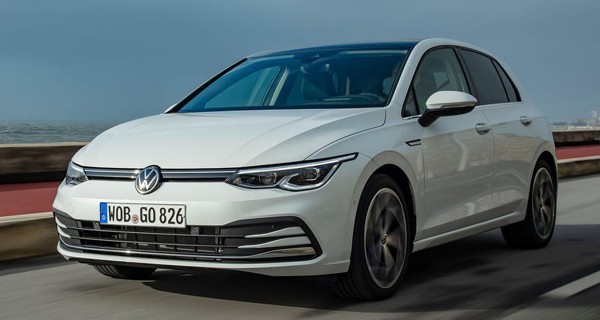 |
|
The
development majors on 3 areas: efficiency, IT tech and cost cutting.
|
|
It seems to me that Volkswagen gave its engineers 3 targets in the
development of Mk8 Golf: One, improve efficiency significantly to meet
the stringent fleet CO2 target in EU;
Two, improve IT technologies
massively to meet the expectation of new generation buyers; Three, to
achieve one and two without raising prices, cut costs elsewhere.
We talk about efficiency first. The last Golf was already very
efficient, using some of the most sophisticated small turbocharged
engines in the mass production world, most notably the 1.5 TSI ACT
engine which incorporates cylinder deactivation (the world’s first on a
4-cylinder engine), Miller-cycle-compatibility and a VTG turbo that
uses exhaust gas energy fully rather than wasting through the
wastegate. What can be improved further? The answer is a mild-hybrid
system. A 48V starter-generator and a small lithium battery is added to
capture energy from deceleration and use it to assist acceleration or
keep the car coasting while shutting down the engine. It saves up to 10
percent of fuel.
Meanwhile, Miller-cycle is used more extensively. Not just the 130hp
version of the 1.5TSI engine, but also the 1.0TSI three-cylinder engine
in 2 states of tune (90hp or 110hp). This is achieved by delaying the
closure of intake valves, reducing the effective compression stroke
while keeping the longer expansion stroke, hence delivering higher
thermal efficiency. In general, you will find the new engines are
slightly less powerful than the old versions. Even if its rated output
is unchanged, the longer gearing it adopted and the economy-oriented
ECU mapping makes them slightly lazier in feel. It is just like when
smog control took place in the USA in the mid-1970s, causing cars to
lose power.
Plug-in hybrid is also improved. Apart from GTE, there is a more
accessible eHybrid added. Both of them employ a 1.4TSI engine and
electric motor, but the battery is enlarged from 8.8 to 13kWh, giving
more range and, most importantly, lowering CO2
figures under WLTP cycles. They differ in only output: 204hp for
eHybrid and 245hp for GTE.
But engines alone are not sufficient. The new Golf’s body is also
smoothened, using more underbody paneling, wheel housing liners,
smoother mirrors and rear roof spoiler to cut coefficient of drag from
the previous 0.30 to just 0.275. For a hatchback, this is remarkable.
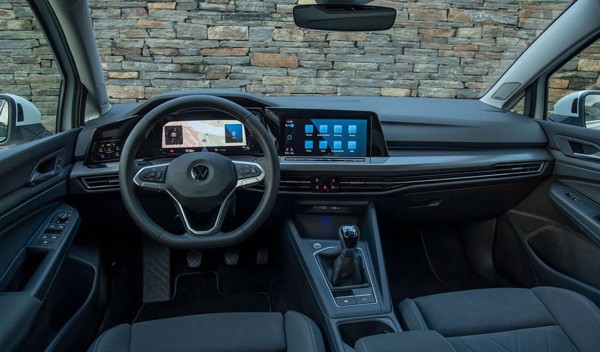 |
|
The
interior styling is controversial. The operation is less intuitive.
Quality is down a little.
|
|
Mission 2 is to build a new electronic architecture. Unfortunately this
is less successful. Golf used to look conventional and functional
inside. Maybe a little conservative, but it has always shine in build
quality, materials and ease of use. The Mk8’s interior still breathes a
premium air, but its dashboard design is a sharp contrast to those of
its predecessors – angular and lack of coherence. To house
the 2 big screens, i.e. 10-inch instrument panel and 10.25-inch center
touchscreen, it moved the air vents to below the screen level and
arranged them in a horizontal stripe that spans the full width of the
cabin. That intents to maximize the perception of cabin width, but
unfortunately, the execution is far from sleek. While Mercedes shows a
simple yet elegant way to install twin-large screens at the dashboard,
Volkswagen’s interior designers struggled to do so. This means the
panel that houses the screens look odd, and the piano-black surface
surrounding the touchscreen looks a little cheap – remember the last
generation Renault Clio did that first?
But worst still is the infotainment system. It should have been the
highlight of the car, but it turns out to be counterproductive. The
user interface might look stylish, but the arrangement is not very
intuitive. Volkswagen deleted hardware switch knobs for even climate
control and audio, so you need to use a touch-sensitive pad below the
center screen for adjustment, which takes your attention from the road,
and it is not always successful. Ditto the stupid voice recognition
system, which is frustrating (admittedly, Mercedes and BMW’s systems
have the same problem, as they are all based on Amazon Alexa.) It seems
that Volkswagen is so good in mechanical engineering, but when it comes
to IT and software, it is a novice. What’s most hurting is, we have
never seen Wolfsburg dared to put untested technologies or unpolished
concept into production, at least not on the Golf before. This might
imply a deeper problem: has Volkswagen abandoned its perfectionist
approach that was put in place by Ferdinand Piech since 1993? It
seems to be not an individual incident, since the launch of ID.3
electric car is reportedly delayed by countless of software bugs. If
Volkswagen downgrades its engineering practices and quality standards
in pursuit of boosting profit margin or to pay the penalties of
Dieselgate, I’m afraid it could repeat the mistake that Daimler made in
the 1990s.
On the plus side, the Golf’s cabin remains a comfortable place. It is
no larger and no smaller than the old car, but it has always been
space-efficient. Even though the wheelbase is shorter than most rivals,
the Golf’s boxy body allows good head and leg room for all passengers,
so 6-footers can sit behind 6-footers. The driver seat is comfortable
and ergonomics is good (except the aforementioned problems, but that’s
not in the way of driving). Soft-touch plastics are used on the dash
top and upper part of the door panels, but some other places revert to
hard plastics, such as the middle of the dashboard and the entire rear
door panels. Now it slips behind Mazda 3 for cabin richness, let alone
Mercedes, BMW and its Audi sibling.
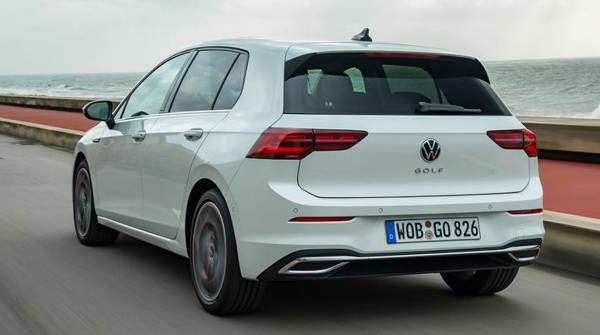 |
|
Still
high on refinement, but driver appeal is improved, too.
|
|
That takes us to the 3rd target: cost saving. Apart from interior
materials, Volkswagen cuts cost also from other places. Open the
bonnet, you will find gas strut is deleted, while the underside of the
bonnet is no longer painted in body color. VW said the latter is part
of the effort to simplify the production process, cutting the total
build time of each car by 4 percent. The first generation MQB modular
platform was a heavy investment, and this investment is paying off in
the latest version, as it requires changing only 20 percent of all
production equipment, significantly reducing retooling costs.
Unfortunately, cost
cutting also leads to killing the 3-door body, as VW said it
contrbuted to only 5 percent of sales. Remember the
original Golf was strictly a 3-door? Our last Golf page featured more
pictures of the 3-door than the 5-door, especially for go-faster
versions. Without the sportier body style, the GTI and Golf R will look
less attractive to us.
Just as the Mk7, most models save costs by employing torsion-beam axle
at the back. Only models with 150hp or higher ride on multi-link rear
suspensions. If you opt for continuous
adaptive dampers, it will be bundled with Dynamic Chassis Control and
an
aluminum subframe. The suspensions are basically carried over from the
outgoing car with minor revisions in spring rates, dampers and
bushings (generally stiffer). Stiffer steering
knuckle is adopted to improve steering precision. The standard steering
is geared a tad quicker than the old car’s, while optional
“progressive” variable-ratio
steering quickens further. Otherwise, the Mk8's chassis
is just the same as the old car.
As a result, the road manner is also largely carried over to the new
car. The Golf is still high on refinement, probably more so than any
cars in the class. Wind and road noises are impressively low. The
1.5TSI engine, no matter at which states of tune, with or without
mild-hybrid, runs smoothly and quietly. There is a good shove offered
from very low revs (torque peaks at only 1500 rpm), and it won’t mind
spinning to 6400 rpm, although not as strongly as Ford’s 1.5 Ecoboost
3-cylinder. Volkswagen’s 6-speed manual has easy gearshift, if lacking
the precision of Ford’s. Its 7-speed DSG is slicker than everyone else.
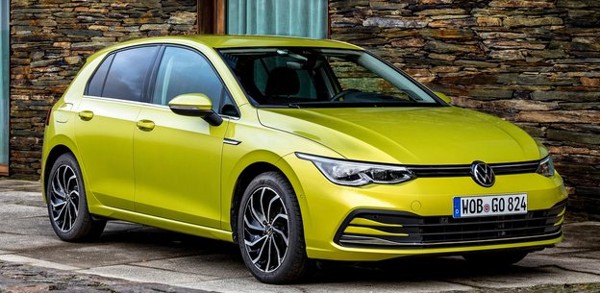
|
|
For
the first time since 2003, the Golf fails to earn 5-star rating on its
debut.
|
|
The chassis is also very refined. Unless you opt for the largest
18-inch wheels, you will find a composed and quiet ride. The suspension
soaks up all but the nastiest bumps. With adaptive dampers set to
comfort mode, it is super supple. Potholes are dealt as if they don’t
exist. But up the pace and it feels a little floaty, so you switch to
Sport mode, and the chassis reveals a sportier edge. Now it is clear
that the chassis of Mk8 is sportier than the Mk7. Its handling is more
precise, its variable-ratio steering feels more direct, weightier in
sport mode yet its response is entirely natural. There is still a thin
layer of insulation from the front wheels compared with the more
communicative Ford Focus or the more hardcore setup of BMW 1-Series,
but it is still a pleasing helm to use. The body control is noticeably
tighter than the old car. Coupling to the quicker steering, the Mk8 is
more capable to attack corners. Don’t get me wrong, the Golf is still
major on comfort and refinement, so it is not going to challenge Focus
or the 1-Series for driver appeal. While it resists understeer better
than before, it does not balance on throttle like the Focus, or
ultimately produces as much front-end grip as the 1-Series. Then again,
none of its rivals ride as comfortably, although Focus is not far
adrift.
Cars fitted with torsion-beam axle is less polished in corner, but the
road manner is similar, placing refinement in high order.
However, the better dynamics is compromised by a redesigned interior
that puts usability and quality perception in doubt. The lack of more
firepower is slightly disappointing, too. So for the first time since
2003, the Golf fails to earn 5-star rating on its debut. It is still
the most recommendable choice for a family car, but the advantage is no
longer that obvious.
|
Verdict:     |
Published
on 9
Feb 2021
|
All rights reserved.
|
|
Golf GTI
|
|
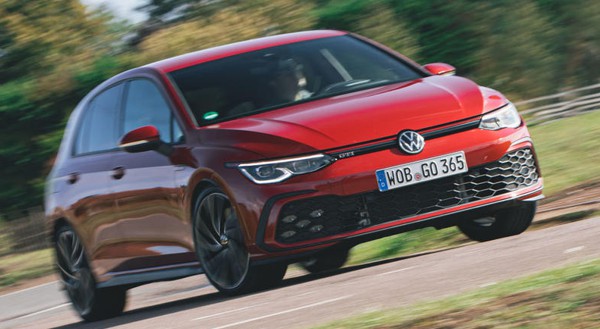
|
|
Probably
the all-rounder that most people desire, just not as great as it ever
was.
|
|
With
the exception of Mk4, Golf GTI has always been the benchmark of hot
hatch world it created back in 1976. It is not very powerful,
especially since Golf R32 / R has taken its place as Volkswagen’s
hottest hatchback. In terms of performance, it is a league lower than
Honda Civic Type R, Renault Megane RS and BMW M135i xDrive, not to
mention Mercedes A45 or Audi RS3. However, for all these years, Golf
GTI has been balancing performance, driving thrills and day-to-day
practicality better than everyone else. In addition to the superior
build quality and “classless” image associated with any Golfs, no
wonder it is usually the best seller.
The latest, Mk8 GTI wants to repeat this success. However, as it is not
a fundamentally new design – the MQB platform of Mk7 is carried over,
as is its EA888 two-liter turbocharged engine, it needs to find
improvements in other areas. The new shape is familiar, but it is
easily distinguishable by employing a honeycomb grille up front. Like
other Mk8 Golfs, 3-door option is abandoned, leaving only the more
popular 5-door body. This body is said to be slightly stiffer and
lighter than the old one, though you won’t find any evidences from its
specifications.

|
|
It
feels tauter, pointer and simply more hardcore.
|
|
The EA888 motor gets higher pressure, 350 bar fuel injection to improve
combustion efficiency. However, its output remains unchanged from the
Mk7.5 revision introduced to the previous GTI Performance in 2017. This
means 245 horsepower and 273 lbft of torque, sounds modest when most
rivals offering between 275 hp and 320 hp. Transmission is again that
6-speed manual or 7-speed DSG, no surprise. Either way, 0-60 mph takes
around 6 seconds, and top speed is capped at 155 mph. It’s not slow,
just not quite as quick as rivals.
In the real world, this motor remains a satisfying workhorse. Power is
delivered smoothly, with little lag below 2000 rpm and a flexible
mid-range. It is cultured, too, with a relatively quiet exhaust and no
pops and crackles on overrun. More firepower and enthusiasm at the top
end would be better, but then again, you know, Volkswagen is holding up
something for the hotter GTI Clubsport and Golf R models.
 |
|
Ride
quality is no longer exemplary on a B-road, losing one of the biggest
assets of the old car.
|
|
Bigger changes lie on the chassis setting. Like the case of the lesser
Golf models, Wolfsburg decided to make it sportier this time around.
The variable rack power steering has its ratio tightened by 5-7 percent
for sharper response. The suspension springs have been stiffened by 5
percent up front and 15 percent at the rear compared with the old car.
Ride height is dropped by 15 mm compared with lesser Golfs, and the
front subframe is replaced with an aluminum item. Besides, the car now
gets a brand new Vehicle Dynamics Management system which integrates
the control of adaptive dampers, steering, DSG, stability control etc.
Footwork is also improved, as you can opt for 19-inch wheels wrapping
235/35 rubbers. Meanwhile, the VAQ electronically variable LSD returns
as standard equipment.
All these changes give the GTI a sportier character. Turn-in is more
incisive, accompanied with better body control. It feels tauter,
pointer and simply more hardcore. On the flipside, the ride gets busier
and less consistent. It is still a relatively refined car in the hot
hatch class, but no longer exemplary on a B-road, losing one of the
biggest assets of the old car, what a pity. Meanwhile, despite the
added agility, the new GTI lacks the throttle adjustability of a Focus
ST or the mighty cornering prowess of a Type R or Megane RS Trophy.
Keen drivers would still choose those cars instead of the VW.
Traditionally, the GTI should claw back many points in the cabin.
Unfortunately, the Mk8 suffers from criticisms about downgraded build
quality (too many hard plastics), worsened ergonomics (most buttons
replaced by a touchscreen) and illogically designed infotainment menus.
Basics like space, driving position and seats are excellent, but you
can’t help wondering why VW engineers could sacrifice its traditional
virtues for the sake of modernization. Don't get me wrong, the new Golf
GTI is still a very good car, and probably the all-rounder that most
people desire, just not as great as it ever was.
|
Verdict:     |
Published
on 10
Feb 2021
|
All rights reserved.
|
|
Golf GTE and GTD
|
|

|
|
GTD
is a good companion for mile-eaters.
|
|
Apart
from the petrol GTI, once again Volkswagen offers a diesel GTD and
plug-in hybrid GTE to broaden the appeal of its hot hatch range. While
the GTI serves traditional hot hatch drivers, the GTD favours
long-distance cruising, and the GTE targets at those seeking financial
benefits of plug-in hybrid. All three share virtually the same exterior
and interior with only the slightest differentiations that you won’t
care, so what separate them are purely down to the different
powertrains and their resultant influence to ride and handling.
Considering diesel has become a negative thing in marketing since
Dieselgate, VW is quite brave to continue selling the GTD. The latest
generation – very likely to be the last as well – continues to employ
the 2-liter single-turbo diesel engine, though it is updated to EA288
Evo. Key changes from the original EA288 include 2200-bar common-rail
injection, increased cooling to the exhaust gas recirculation
(therefore reducing the formation of NOx) and the employment of 2 SCR
converters (one at the upstream and one at the downstream of exhaust,
therefore cutting NOx by 80 percent). Meanwhile, output is improved
from the old engine’s 184 to 200 horsepower, while max. torque is
lifted from 280 to 295 lbft, available between 1750 and 3500 rpm. The
new GTD is good for 152 mph and 0-60 in 6.7 seconds, not quite as quick
as the petrol GTI, but it achieves much better fuel economy and CO2
emission, i.e. 137 g/km vs 168 g/km.
The GTD is a long-leg performer. It is no match for the GTI in terms of
response and high-rev refinement, also lacking some aural appeal
(although the GTI is not particularly strong either). It works
effortlessly in the mid-range, providing superior in-gear acceleration
thus is a good companion for mile-eaters.
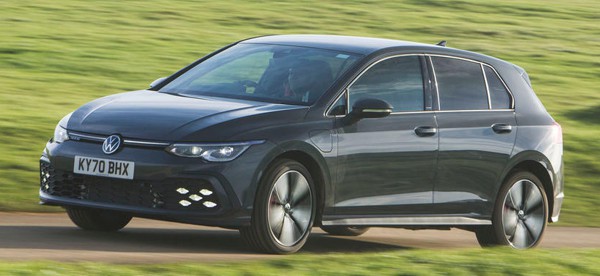 |
|
If
not taxation benefits, I guess nobody would choose GTE over the
identically-priced GTI.
|
|
The GTE is not a brand-new design either. Its powertrain is lightly
improved from the last generation, still consists of a 1.4 TSI engine
with 150 hp and an electric motor that is integrated with the DSG
gearbox. No wonder the latter remains a 6-speeder. Volkswagen has
fitted the engine with higher pressure fuel injection for improved
combustion efficiency, but the most important development is giving it
a larger battery with 13 kWh of capacity instead of the previous 8.8
kWh, and boosting its electric motor’s output from 102 to 109 hp. As a
result, pure electric driving can be used for longer and more of the
time in normal driving, extending its zero-emission range to 64 km and
lowering its WLTP emission to 36 g/km. The GTE has a combined output of
245 hp, identical to the GTI, while its maximum torque matches that of
the GTD at 295 lbft. Is it the best of both worlds?
Its performance is good enough, with 0-60 done in a respectable 6.4
seconds – significantly better than the old car’s 7.2 seconds quote –
although the electric power doesn’t help it at the top, so you get only
140 mph flat out. The hybrid powertrain offers superb refinement at low
to medium speeds, especially when only the electric motor is working.
Push harder, and you will hear the 1.4-liter engine working overtime to
keep up the demand. That noise is also less attractive than the GTI’s
larger engine. Still, with electric boost, there is plenty of torque
for overtaking.
The GTE is at least 160 kg heavier than the GTI, as its battery alone
already weighs 135 kg. The battery is placed under the rear seat, so it
helps improving the front-to-back balance and keep the center of
gravity low. However, there is no way to ignore the additional weight.
If you are asked to add 160 kg of ballast to your race car, you will
call the race organizer crazy. No matter where you place that ballast,
there is no way to keep up with your lighter rivals. The same goes for
the GTE, which handles as good as a warm hatch goes, but no way to
match the GTI. Besides, the stiffened suspension necessitated by the
extra load inevitably results in a less polished ride.
All in all, the GTE can only be the accountant’s GTI. If not taxation
benefits, I guess nobody would choose it over the identically-priced
GTI. Choosing the GTD at least makes some sense with its lower price
tag and a different, more relaxing driving character.
|
Verdict:    |
Published
on 22
Feb 2021
|
All rights reserved.
|
|
Golf GTI Clubsport
|
|
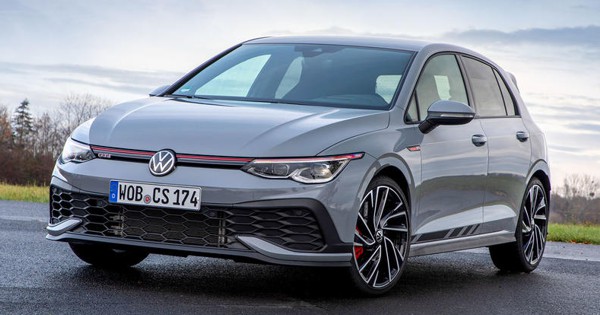
|
|
It
has all the ingredients to succeed: 300 horsepower, VAQ differential,
adaptive dampers and even a "Nurburgring" mode...
|
|
The
fastest Golf has always been the R model. However, not all keen drivers
buy the idea of a 4-wheel-drive hot hatch. Many prefer the simpler,
more transparent control of front-wheel drive and the weight saving
benefited by keeping the car simple. Therefore, starting from the last
generation Wolfsburg offers the Clubsport model. It targets at the same
crowd of Renaultsport Megane and Honda Civic Type R (now also Hyundai
i30N).
The new Clubsport is significantly more powerful than the last one. Its
EA888 engine, now at the fourth generation, gains 350-bar fuel
injection along with a new turbocharger with higher boost pressure,
producing a full 300 horsepower and 295 lbft of torque. That’s 10hp and
15lbft stronger than even the old car on overboost. A little bit
disappointing though, it is equipped with 7-speed DSG mandatorily, so
the true hardcore drivers might decline to recognize it. Volkswagen
claims 0-60 is done in 5.3 seconds, a tenth less than Civic Type R,
Megane RS Trophy and Ford Focus ST.
Predictably, the car has VAQ electronic LSD equipped as standard, and
its tuning is different from that of the GTI. The suspension gets 10mm
lower, stiffer, with increased negative camber at the front wheels, but
adaptive dampers are left in the option list for a car that starts at
£37K, which seems a bit expensive. You do need those variable
dampers to deliver the best, because it widens the bandwidth of its
ride comfort and control. Moreover, with this option, the drive mode
selector offers an additional “Nurburgring” mode, which dials up
everything else but soften the suspension a little to best dealing with
bumpy mountain roads. The Clubsport gets deeper chip spoilers and
larger rear spoiler as well as 357mm front brakes from the heavier Golf
R. Tires are 225/40R18 Bridgestone Potenzas as standard, while optional
235/35R19 Michelin PS Cup 2 rubbers are essential to set a Nurburgring
lap time of 7:54. It’s not quite as quick as the Type R or the
stripped-out (but very expensive) Megane Trophy-R, so there is space
left for a Clubsport S.
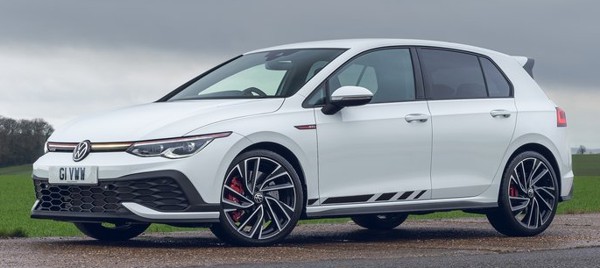
|
|
What
it really fails to beat its rivals is to engage its driver...
|
|
On the road, the Clubsport is markedly quicker than the GTI, naturally.
Power delivery is stronger at the upper rev range, but it still lacks
the top end magic and firepower of the Honda motor, or the delicious
noise of Ford’s 2.3-liter. Isn’t it a little bit too civilized?
Likewise, the DSG box works efficiently, but it is not particularly
responsive, and the lack of full control (it will upshift automatically
at any modes) robs it driver engagement. In short, the powertrain feels
more civilized than the class norm, lacking the frenetic edge you need
in this class to impress, even though the car is actually quick.
The chassis is similar. Ride is definitely harder than the usual GTI
standard, but it remains highly usable on everyday basis. Noise sources
from road, tires and wind as well as vibrations are better suppressed
than its rivals. Body control is tight. Throttle steer is not hard to
induce. Traction and grip are good, but be aggressive in tight corners,
the VAQ could fail to contain wheelspin, as it takes a while to react
and regain traction. That makes the car’s front axle feeling less
knocked down, less trustable than the Honda or Renault. Equally
disappointing is the typical Volkswagen steering: precise, well
weighted and well geared, but when it comes to tactile feedback from
the tarmac, it offers little.
The Clubsport does not lack speed or control. It also blends the
“premium” element with performance better than anything else in the FWD
market. What it really fails to beat its rivals is to engage its
driver, no matter through noise, engine response, gearshift, steering
or at-the-limit handling. It is good only up to a point. Then again, it
is probably no surprise, as the brand is not famous for hardcore
driver’s cars. Let’s see if the upcoming Golf R would be better.
|
Verdict:     |
Published on 23
Mar 2021
|
All rights reserved.
|
|
Golf R
|
|
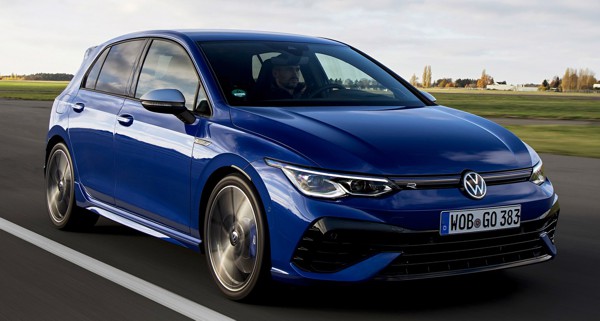
|
|
Torque
vectoring 4WD gives the new R extra capability to entertain its
driver...
|
|
Volkswagen’s
R badge started life in 2002 with the first R32, which was based on
Golf Mk4. It employed a 3.2-liter narrow-angle VR6 engine and a 4WD
system named “4motion”, both were innovations then. The VR6 was one of
my favourite technical innovations in the automotive field. It occupied
the same space as a 4-cylinder engine yet offered 6-cylinder power and
smoothness. Meanwhile, the 4motion system made use of a Haldex
multiplate clutch to direct torque rearward, saving the need for heavy
and costly center limited slip differential.
However, today’s Golf R employs neither VR6 nor the traditional
4motion. Since 2 generations ago, the novel motor has been replaced
with a 2-liter turbo four in order to meet emission targets while
lifting output. The 4motion concept soldiers on longer, but it is
finally shelved in the latest Mk8. A multiplate clutch still exists,
mounted near the rear axle to engage the latter on demand, but now the
rear differential has been added with a pair of multiplate clutch packs
to do torque vectoring, allowing 100 percent of the available rear axle
torque to be directed to either rear wheels, so to neutralize
understeer or even introduce oversteer. No wonder it allows a new Drift
mode. That’s a true step forward, making the Golf R superior to its
relative Audi S3 or other Volkswagen group cars, although it keeps
using the “4motion” name.
It must be noted that the Golf R’s 4WD system is not capable to send
more than 50 percent torque to the rear axle (unless the front wheels
are slipping), because its rear axle turns at the same rate as the
front. The GKN Twinster system of the outgoing Ford Focus RS, in
contrast, had its rear axle geared to turn faster, introducing a speed
difference for its clutch packs to make use of. That’s why it could
transfer up to 70 percent torque to the rear. On the downside, the
Twinster ran with constant clutch slipping all the time (unless the
rear axle is completely disengaged), so it had more wear and energy
loss. The Golf R should be more fuel efficient and durable.
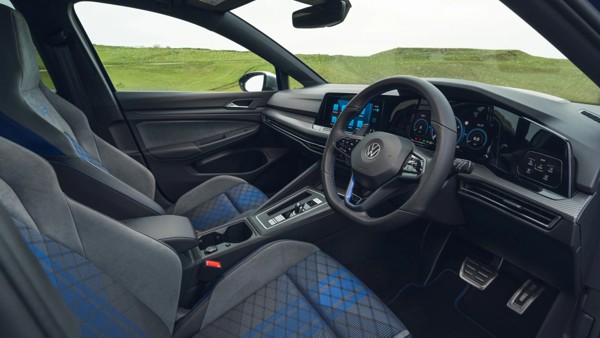
|
|
It
won’t make you tiring in a long journey, just as easy to live with as a
regular Golf TSI.
|
|
The 4th generation EA888 engine employs a higher direct injection
pressure and other detailed improvements, lifting horsepower by 20 to a
total of 320hp. Torque is boosted by 30 to 310 pound-foot, available
across a wide band from 2100-5350 rpm. Admittedly, the Mk7 model once
produced 310hp and 295 lbft from 2017-19, so the power gain this time
is rather modest. Moreover, the new car carries 56kg more weight, no
wonder its performance claims are virtually unchanged, with 155 mph top
speed and 0-60 mph taking 4.5 seconds. That’s for the car equipped with
7-speed DSG gearbox. 6-speed manual, now available exclusively to the
US market, should be a little slower.
Modifications to the rest of the car is predictable. The R's suspension
is set 20mm lower than that of the cooking models or 5mm lower than the
GTI, accompanied with springs and anti-roll bars that are 10 percent
stiffer than the old R. The front wheels are set with more negative
camber to improve grip and cornering agility. The front subframe is
converted to aluminum to save weight. DCC adaptive dampers continue to
be optional. The front brakes have been enlarged from 340 to 357mm, but
they are still lighter, thanks to switching to aluminum disc hubs and
calipers.
And then there is the optional R performance pack. It lifts the speed
regulation to 168 mph (still 1 mph down on Civic Type R), brings
19-inch wheels, a larger rear spoiler and 2 extra driving modes: Drift
and Special. The former uses more torque vectoring to enable drifting
in corners, while the latter combines softer adaptive damper setting
with sportier settings for everything else, suitable for attacking
B-roads. The new Golf R used Special mode to lap Nurburgring in 7:53,
17 seconds quicker than its predecessor.
The only area getting worse is price. When the Mk7 made debut 6 years
ago, it cost a bargain sub-£30,000. Price kept increasing over
the years, and now the Mk8 debuts with a starting price close to
£40,000. Add the £2,000 R performance pack (not essential),
£800 adaptive dampers (must have) and a few options, it can
easily top £45,000. A true premium hot hatch.
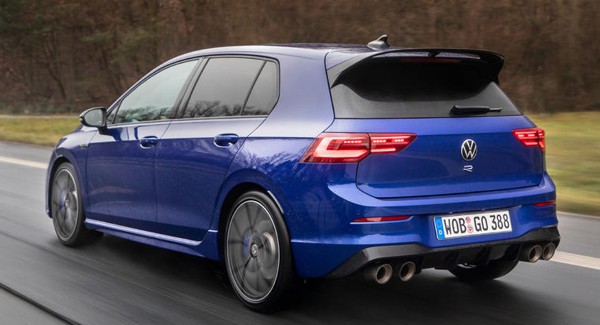
|
|
Combining
the best of both worlds is still the unique quality of the Golf R.
|
|
On the Road
Any hatchbacks capable of reaching 60 mph from a standing start in 4
and a half seconds have to be called quick, but frankly, the Golf R
doesn’t feel as quick as it ought to be, because the EA888 engine is
too well mannered. Its exhaust note is subdued and lacks character. Its
power delivery is so linear that lacks drama. There is very slight
turbo lag below 2000rpm, once overcome it spins smoothly towards the
6700 rpm redline, without any particular power kick in between. Unlike
the Honda motor, it doesn’t turn mad at the upper end. Nor its exhaust
crackles on overrun as aggressively as the AMG A35 motor. Having said
that, the EA888 motor has always been like this. The DSG’s smooth and
quick shifts remain, too. The flipside of such a civilized manner is
excellent refinement for everyday driving. It won’t make you tiring in
a long journey, just as easy to live with as a regular Golf TSI.
Ditto the absorbent ride (when the suspension is set to Comfort mode)
and the near impeccable isolation from wind and tire noises. Among its
premium competitors (A35, M135i and S3), the car with the least
prestigious brand is actually the most premium feeling in the
department of ride and running refinement. As in other Golf 8 siblings,
the cheaper interior plastics and cumbersome touch controls might let
down, but this is still a solid, spacious and practical family hatch.
What impress you is, when you start pushing, you will uncover the deep
reserves of its talents. The steering is direct (2.1 turns from lock to
lock), meaty yet offers decent feel, relaying the level of front-end
grip to your hands. The brakes are not only powerful but the pedal is
feelsome and progressive. Traction and grip are strong, confidence
inspiring. Roll builds up progressively to give you a good sense of the
cornering state. As before, it turns into corner eagerly, but
understeer is even better managed. Push harder, you feel the power
shifting rearward, and the outside rear wheel fires the car into the
apex. With or without Drift mode, the new Golf R feels more neutral at
the cornering limit than its predecessor. It is also significantly more
adjustable on throttle, pushing to a few degrees of oversteer is easy,
although power sliding like a rear-drive M2 Competition is probably too
optimistic. Playful aside, the clever 4WD system offers bags of
traction, allowing you to be back on power early in corner exit. Its
handling is both efficient and entertaining.
Both Toyota GR Yaris and Mercedes-AMG A45 S provide the same kind of
total traction and adjustable handling, but the Golf R is more clinical
and measured in its actions, more refined and more relaxing in normal
driving. Combining the best of both worlds is still the unique quality
of the Golf R. A track day hero? Not quite as good as Type R or Megane
RS Trophy-R, but it is more versatile and probably the one you would
choose if you can own one car only.
|
Verdict:      |
|